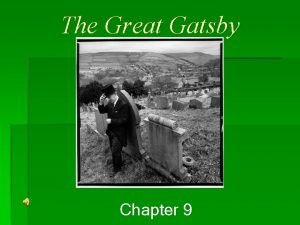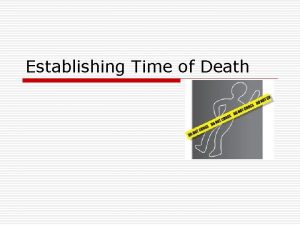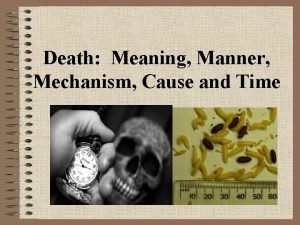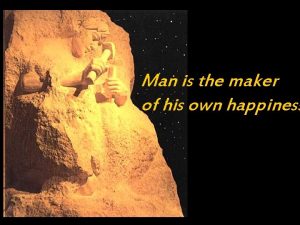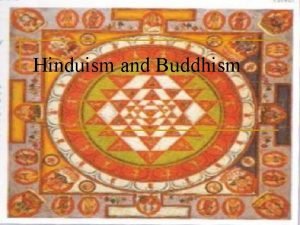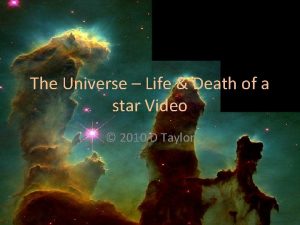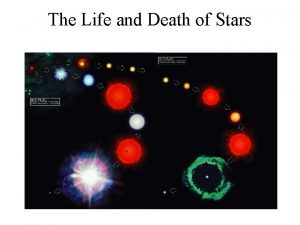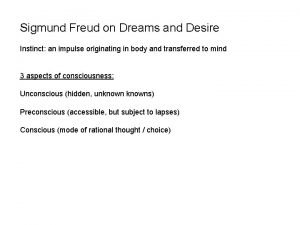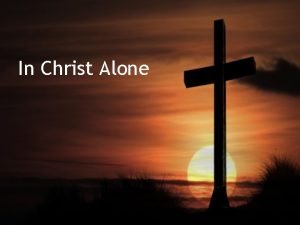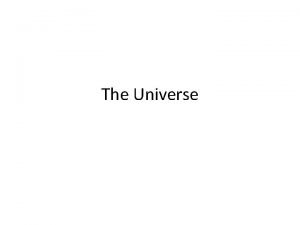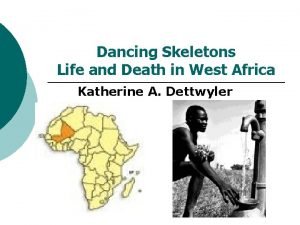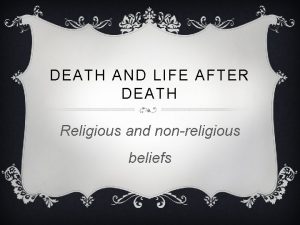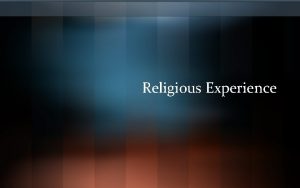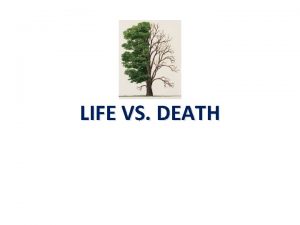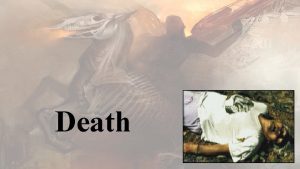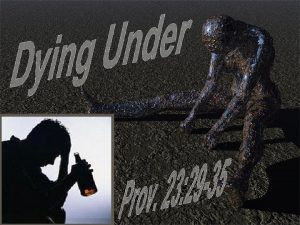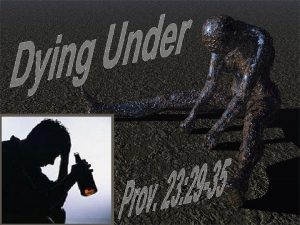Religious Views of Life After Death Views of
































- Slides: 32

Religious Views of Life After Death Views of life after death associated with the ancient and modern religious traditions of the world

The Land of No Return In Greek mythology, Charon, the old ferryman, guides a small boat that carries souls from this world into the afterlife, into Hades, the land of no return.

Earliest Evidence of Human Belief in Survival of Death Archaeological Evidence The practice of intentional human burial, which dates back to at least the Neanderthal period (300, 000 - 30, 000 BCE), provides evidence of the concept of death among early humans.

The practice of ritual burials among later Neanderthal and Cro Magnon humans is suggestive of the concept of survival of death among early humans. Archaeological Evidences of Ritual Burial 1. Unique positioning of the corpse (e. g. , fetal position) 2. Painting the corpse or covering it with carved stones or plants. 3. Clothing and decorating corpses with jewelry (e. g. , pendants, bracelets, necklaces, beads). 4. Burying corpses with other “grave goods” (e. g. jewelry, tools)

Belief in survival of death appears to be a prehistoric belief.

The Afterlife, Desirable? Many of the earliest literary expressions of an afterlife do not depict it as a desirable or pleasant place.

Epic of Gilgamesh (circa 2000 BCE): After death, the human person goes to the netherworld as an etemmu (ghost or shade). The “shade” is a ghostly double of the human person, and the netherworld is a gloomy subterranean realm.

The idea of the continued existence of a person as a ghost in the Netherworld was common throughout Mesopotamia by 2000 BCE.

The Sumerians, Assyrians, and Babylonians also believed that the spirits of the dead could be agitated by disturbing their graves or the failure to perform proper funerary or memorial rites. Agitated spirits of the departed could haunt the living by inflicting physical and psychological harm on them.

Portions of the Hebrew Scriptures (circa 800 -500 BCE) The dead go to “sheol, ” but some are capable of being raised as spirits or ghosts. (e. g. , I Samuel 28) The Iliad and the Odyssey (circa 750 -650 BCE ) The dead go to Hades (the underworld). “There remains then even in the house of Hades a spirit and phantom of the dead, but there is no life within it. ” (Iliad 23).

Elitist Conceptions of the Afterlife Positive conceptions of the afterlife are found in ancient religion, but their earliest expressions represent a largely elitist view of the afterlife. Ancient Egyptian Religion In the Old Kingdom (3 rd millennium BCE), immortality typically belonged exclusively to the Pharaohs and the priesthood.

Significance of these Afterlife Concepts 1. Belief in survival of death did not arise because people hoped they would survive death. It wasn’t the product of wishful thinking. 2. Belief in survival of death did not arise as a way for political systems to control the masses, nor as any kind of social control mechanism. 2 a. If the afterlife is not a place of rewards and punishments, it can’t be used as an incentive to behave in some particular way. 2 b. If the afterlife isn’t for the masses, it has no relevance to their lives.

Morally Relevant and Universal Conceptions of the Afterlife Everyone survives death but the afterlife involves punishments and rewards for deeds done on earth.

Mesopotamia and India Circa 1400 BCE…. Mesopotamia - the 12 th tablet of the Epic of Gilgamesh. The quality of life in the Netherworld varies depending on the quality of one’s earthly life. India – Rig Veda (of the sacred Vedas) The virtuous receive a new body after death and enter “the world of the fathers” (a heavenly realm of pleasure and joy occupied by one’s ancestors and the gods), but the wicked are cast into a dark pit.

The judgment souls in the afterlife. BCE), allows people By the time ofof theindividual New Kingdom (1539 -1075 Egyptian who are neither nor pharaohs tothe attain immortality. religionpriests had “democratized” afterlife.

The Afterlife and the Self Universal and morally relevant conceptions of the afterlife become widespread in the first millennium before the common era, during the socalled axial period.

The Axial Period (800 -200 BCE) Zoroaster (prophet of Zoroastrianism) Siddhartha Gautama, the Buddha Greek philosophers Socrates, Plato and Aristotle Completion of the Hebrew Scriptures (the Old Testament) Composition of the sacred Hindu texts of the Upanishads and Bhagavad Gita

Two Important Features of the Axial Period Ideal Self Beatific Conception of the Afterlife Pre-Axial Period Underdeveloped concept of self Underdeveloped concept of the afterlife

The Rise of “the Soul”

The Socratic dialogues affirm the existence of the self as an individual soul, an immaterial, simple substance that intrinsically has immortality. The soul can enter a divine world after death, otherwise it might be reborn in a new body on earth.

The Upanishads in India affirmed the existence of a true self (atman) that transcends the individual self of our present experience.

The Persian and Hebrew traditions affirmed the existence of an individual self that will survive death, first in the form of a disembodied soul and subsequently as a physically resurrected person (soul -body unity).

Zoroastrianism (the religion of ancient Persia) affirmed a beatific afterlife for all worshippers of the one true God. The soul (urvan) of the dead person goes to a heavenly realm after death. The soul is rejoined to the body at some time in the future when God conquers all the forces of evil.

The wicked enter a place of punishment after death (hell), but exist there only for a limit time. All people are eventually redeemed.

Afterlife Moral Judgment of the Individual The Existence of God Creator, Lawgiver and Judge

By the 2 nd century BCE, the doctrines of disembodied soul-survival and a future bodily resurrection from the dead are both explicitly acknowledged in Judaism. These ideas eventually work their way into Christian and Islamic theology in the common era.

Hinduism - Reincarnation The Upanishads (circa 800500 BCE) and the Bhagavad Gita (500 -200 BCE) explicitly affirm the doctrine of reincarnation (samsara), roughly the idea that the soul is reborn in new bodies until the cycle of death and rebirth is broken and the soul is liberated (moksha).

Buddhism – Rebirth and Bardo From its inception in the 5 th century BCE, Buddhism affirmed the Hindu doctrine of samsara (rebirth). Unlike Hinduism, Buddhism does not affirm the existence of an individual soul (jivatman) or true unchanging self (atman). Buddhism has typically understood rebirth to be the continuation of a changing stream of consciousness or pattern of dispositional tendencies.

The Tibetan Book of the Dead (circa 8 th century CE) affirms the existence of Bardo, a state of consciousness between physical death and rebirth.

Afterlife Views at a Glance Eastern Religions Western Religions (Hinduism, Buddhism, Taoism) (Judaism, Christianity, Islam) Reincarnation Bodily Resurrection Eastern and Western Religions Disembodied Survival (Intermediate State)

The Afterlife and God Ideal conceptions of the self are parts of the larger metaphysical framework of the religious traditions of the world. Vision: These metaphysical frameworks invariably teach the existence of a reality that transcends the physical world and our present experience (Yahweh, Brahman, Ahura Mazda, Allah). Purpose: Religion attempts to relate human individuals to this higher reality, to personalize the transcendent. Means: The afterlife provides a context in which this divinehuman relation is actualized and developed. Some form of transcendence is achieved.

The. Soul’s Land of No Return The Great Journey The exploration of the nature of the self and the nature of ultimate reality.
 After me after me after me
After me after me after me If any man comes after me
If any man comes after me Tolkiens elves
Tolkiens elves What do muslims believe in
What do muslims believe in Difference between somatic and molecular death
Difference between somatic and molecular death Corpse wax
Corpse wax Great gatsby chapter 9 summary
Great gatsby chapter 9 summary Stages after death
Stages after death Foamy liver is seen in putrefaction
Foamy liver is seen in putrefaction After death images
After death images Meaning:manner
Meaning:manner Questioning faith after death
Questioning faith after death Casper's dictum
Casper's dictum Social injustice examples
Social injustice examples Continous medulla
Continous medulla Why does ekwefi wake okonkwo early in the morning?
Why does ekwefi wake okonkwo early in the morning? Occuring after death
Occuring after death Rabbit hair medulla
Rabbit hair medulla Star death video
Star death video The life and death of stars
The life and death of stars The death drive
The death drive What is the lineage of prophet muhammad
What is the lineage of prophet muhammad What type of design principle is used in the royal altar
What type of design principle is used in the royal altar Hope in christ alone
Hope in christ alone Life assemblage vs death assemblage
Life assemblage vs death assemblage In life and in death we belong to god
In life and in death we belong to god Star life cycle from birth to death
Star life cycle from birth to death Star life cycle from birth to death
Star life cycle from birth to death Star life cycle from birth to death
Star life cycle from birth to death Lynette stewart cardall
Lynette stewart cardall It is allah who gives life and death
It is allah who gives life and death Light of the world by darkness slain
Light of the world by darkness slain Dancing skeletons life and death in west africa
Dancing skeletons life and death in west africa






